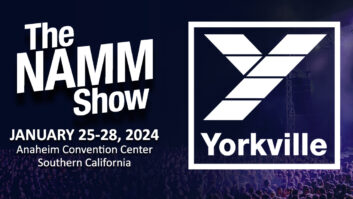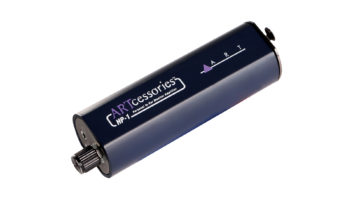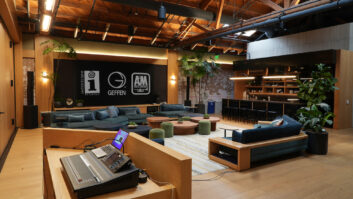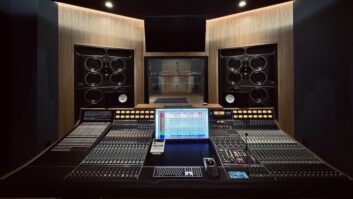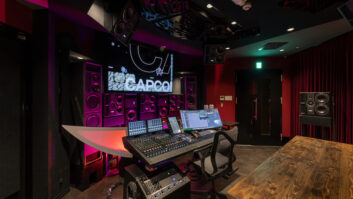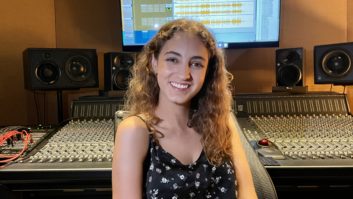The recent boom in the popularity of anime, both on TV and DVD, has seen the introduction of dozens of shows to the U.S. market each year, as well as a few scattered theatrical features and shorts on the festival circuit. At the same time, producers fighting to make their shows stand out from a newly crowded pack have brought much-needed attention to the soundtracks, particularly to the voice dubbing.
Differences do exist between Japanese and American dubbing processes. While Japanese recording sessions for anime series involve multiple cast members and crew and usually average four hours per 30-minute episode, American dubbing sessions are done one actor at a time and take two to three days per episode. When it comes to features, they can take longer, as with the Disney dubs of Japanese director Hayao Miyazaki’s films. Those average eight weeks to complete.
A HIGHER MAGNITUDE
Les Claypool (not the bassist for Primus) has owned Magnitude 8 Post for two decades and has been involved for 15 years in dubbing anime series such as Ghost In the Shell: Stand-Alone Complex and movies such as the cult classic Akira and the recent Appleseed. Early in his career, Claypool spent a lot of time fixing bad dubbing jobs by other studios; he still does that today.
“We are currently working on a 26-episode series that’s just the biggest mess I’ve seen in 20 years,” Claypool says. “We’re restoring and remixing it. There’s very limited funds to dub this stuff, so of course they go with anybody who says they can do it. Then I usually fix it and tell them, ‘If you had come to me in the first place, it still would have cost 40 percent less than doing it twice.’”
Magnitude 8 has two locations: an Arleta, Calif., facility for ADR and dialog editorial, and a Burbank address for music, effects and mixing. While the company does not do casting or directing, Claypool does have a relationship with Yutaka Maseba, president of Zero Limit Productions, a California-based company specializing in English adaptations that he operates with his partner and VP, Haruyo Kanesaku. Claypool’s company then tracks, edits and either mixes or supervises the mixes.
At Magnitude 8’s Arleta studio, the rooms are purpose-built for ADR. “It’s all Pro Tools — based, all removable SCSI drives that we can run around town with,” explains Claypool. “We keep the Pro Tools rigs really stripped-down. That way, we minimize crashes when we have actors backing up and clients watching. Minimal plug-ins and tons of RAM is how we keep all that flowing smoothly.”
The studio is equipped with Mackie and Tascam consoles used solely for monitoring. Either Avalon or Neve mic pre’s usually go directly into Aphex 661 compressors, which then go straight into the Pro Tools interface. They never bus and go through a board, according to Claypool.
The studio’s microphone of choice is a Neumann U87, but they do possess many Audio-Technica tube mics including the 4060 and shotguns such as the 416. “For anime, it’s usually a combination of 87s and BLUE Mouse,” reports Claypool.
Claypool believes that the essential elements that make up a good ADR facility include quiet, pure signal path, tight acoustics, floated floors and “all the usual stuff that real recording studios know about,” he quips. “Then there’s trying to keep it relatively close-miked, which is really difficult to do. You’re trying to get good, rich, thick voices, which is not the case for commercial stuff, feature films and TV, which is more off-mic, shotgun-type of recording because you’re trying to create a sense of air around the mic. We’ve even had our Avalons modified. Avalon calls it the ‘Mag 8 Mod’ so we can actually do that.”
THE IMPORTANCE OF VOICING
Proof that anime has gained a foothold in American popular culture is witnessed by the fact that popular anime series have been luring stronger and stronger voice talent. When it comes to features, Disney’s English-language dubs of Miyazaki’s award-winning films (including Nausicaa of the Valley of the Wind, Kiki’s Delivery Service and the Oscar-winning Spirited Away) have attracted top-notch Hollywood actors such as Michael Keaton, Uma Thurman, Daveigh Chase, Michael Chiklis, Peter Boyle, Cary Elwes, Anne Hathaway and a slew of others.
“We record them one person at a time and shape and mold their performance,” says Rick Dempsey, senior VP of Disney Character Voices, who has directed most of the company’s dubs of Miyazaki films and recently co-directed Howl’s Moving Castle with Pete Docter (Monsters, Inc.). “Obviously, the differences between U.S. animation and what we’re doing with the Miyazaki films is that in the domestic productions that we have, we get to record the voices first and have the luxury of animating around them.” He points out that Disney dubs its films in about 36 languages. “It’s rare where we get to take someone else’s product and dub it into English.”
At Disney, actors are recorded into Pro Tools. The studio usually uses a Neumann U87 microphone for all of its recording. Like Magnitude 8, Disney uses a Doremi V1 video deck for visuals. The hardest obstacle to overcome, according to Dempsey, is getting natural performances from actors who are trying to match the rhythms of pre-existing mouth flaps as opposed to their own natural rhythms. The challenge is to get a good flow to the performance.
Main characters are recorded in the Disney Character Voices Recording Studio, which Dempsey says is small but has a good sound for recording and mixing. On the rare occasion that an actor is working out of New York, Dempsey and Disney will record in another studio there. Walla sessions on the Miyazaki releases are done at Studio B on the Disney studio lot and feature up to 15 actors at once. (Due to its larger budget, Howl’s Moving Castle was all recorded on Stage B.)
“We will have a walla session during a scene such as a riot, sporting event or concert, which call for the recording of a large crowd,” explains Zero Limit Productions’ Maseba, of the casting firm that works with Magnitude 8. “The Japanese call this ‘Gaya.’ We’ll have a group of men, women or both, and have them speak about various things that pertain to the scene. The idea is to have dialog that isn’t really needed to be understood by the audience, but to bring about an emotion during that scene. We also listen to the original Japanese walla recording to pick out certain audible walla and incorporate that into our scripts. The Japanese scripts usually say to improvise, but once again, we will go the extra mile to stay true to the original Japanese recordings.”
“There are a lot of libraries where it is already on CD, and they probably just cut it in Japan,” says Claypool, who tends to record walla sessions in groups of five. “But if you want any specifics, walla groups will actually study the movie itself and what they’re supposed to be talking about.”
Whether or not individual tracks are compiled or larger group sessions are recorded depends on the scene. “Sometimes we’ll do a huge crowd — we’ll do what we call a donut,” says Dempsey. “If it’s a moving scene, we’ll have all 15 talent form a circle and make a giant donut and they walk around and have different proximities to the microphone. They’re all making noise, but it gives you a variation, so it’s not a static sound and you get a little bit of movement, especially if you use a stereo mic” Disney’s mic selection varies and includes a Neumann TLM 170 and U87 or a Sennheiser shotgun microphone, “depending upon what the scene looks like.”
LOOSE LIPS SINK SYNC
Maseba observes that the biggest difference between dubbing in Japan and America is lip sync. “Japanese dubbing is acceptable as long as the dialog starts when the first frame of the animated character’s lips open and ends when the last lip flap closes,” he explains. “In the U.S., the process starts with our dialog script writers, who write dialog that will specifically synchronize to the animated lip flap movements. From that point, the actors and directors work hard to make sure everything syncs while giving a natural performance. Even after recording, our studios will edit the dialog to make sure everything fits together perfectly.”
The amount of editing in American productions varies. For the Miyazaki films, says Dempsey, “We try to shoot all the dialog in a clear-cut fashion and get it as close to sync as possible. There are just some times that we love a performance but it’s not the best lip sync.”
Claypool observes that some directors get what they want by doing multiple takes, “and maybe slip it a frame one way or the other, but some of the other directors will track eight to 10 takes of this stuff and start cutting and pasting. Then we’ll get a hold of it in editorial and, depending on the project, we can take it all the way down to the level of pluralizing words by sticking an ‘s’ at the end of a sentence. Quarter-frame bumps are pretty normal for dialog editorial. You wouldn’t think a quarter-frame matters.”
Maseba notes some differences in the way dialog is tracked in Japan. He says that during an entire cast session for one episode that usually lasts only four hours, two takes of the show are done with pickups recorded afterward. Actors stand before a three-mic setup, surreptitiously sliding back and forth to the mic when it is their turn, quietly turning pages and some even removing their shoes to avoid making shuffling sounds.
“You see them holding the script in front of their faces to the side of the monitor and they move the script away from the mic to turn them,” illustrates Maseba. “Stateside, we usually track the dialog in groups of three or four episodes with individual actors unless there is a walla session. We average three days per episode, so a recording can last up to nine or 12 days. The other thing we do differently is track one loop at a time. Really good actors can record several loops in one take.”
STAYING TRUE TO THEIR ROOTS
Aside from dialog, Claypool and Dempsey agree that preserving the original music and effects tracks is paramount. “One of our philosophies is never cover the Japanese effects with new effects,” states Claypool. “If you’re going to do anything at all, blend them in because it’s sort of presumptuous and disrespectful to listen to it and go, ‘None of that’s any good, so why don’t we just cover it with more stuff?’ We tend to just blend it in, so you may not know we’ve been there, but your speakers will rumble a little more.”
Claypool adds that standard procedure is to be given to M&E tracks, and if he is lucky, they are already split. “But many times, they give you a comped-down M&E, where you have no control over anything except a little volume dipping and EQ here and there,” he notes. There may occasionally be music changes, but his company tries to keep things as true to what they have been given as possible, including the relative volume levels between the American and Japanese language tracks.
One of Magnitude 8’s trademarks is perspective cutting, including plenty of reverbs and slaps. “If you’re out in the forest, give it a little slap,” says Claypool. “If somebody’s 10 feet away from the other person and they’re talking back and forth, dip the volume and roll a little EQ out, and put a little low end out of the distant voice and put a little bit of room on them.”
At the end of the day, both Disney and Magnitude 8 strive for the best sound and performances as possible to offer a quality product and keep viewers engaged. Dempsey hopes that those viewers who prefer watching the Japanese originals with subtitles will try out the American dubs and get sucked into those performances, which he feels are as equally good.
“Traditionally, dubbing has been seen as a dark cloud, something that’s always been done poorly here in the U.S.,” Dempsey admits. “Think of the traditional Godzilla movie — that’s an American audience’s vision of dubbing. We’re just trying to be meticulous about this and take it to a whole new level so that people can appreciate these films without having to read subtitles.”

